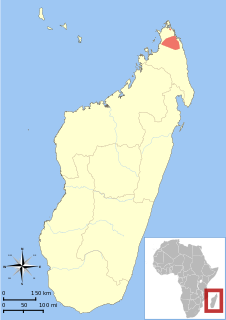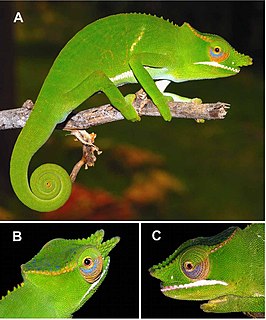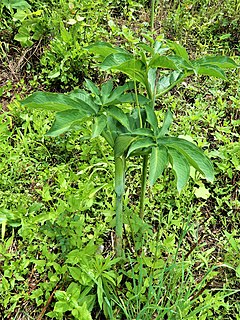
Anthurium is a genus of about 1,000 species of flowering plants, the largest genus of the arum family, Araceae. General common names include anthurium, tailflower, flamingo flower, and laceleaf.

The crowned lemur is a lemur that is 31–36 cm (12–14 in) long and weighs 2 kg (4.4 lb). Its tail is about 42–51 cm (17–20 in) long.

The northern rufous mouse lemur, northern brown mouse lemur, or Tavaratra mouse lemur is found in Northern Madagascar from the Ankarana National Park in the West to the river Manambato in Northeast and up to the Irodo river in the North of the Analamerana Special Reserve. The complete distribution range of M. tavaratra is still to be defined as some areas surrounding the described distribution have not been visited yet. For example, M.tavaratra has been reported to possibly occur from the Irodo up to the Montagne des Francais by Louis and collaborators in. Its known distribution cover four protected areas the Ankarana National Park, and the Analamerana Special Reserve both managed by Madagascar National Parks, the Loky-Manambato Region (Daraina) and the Andavakoeira-Andrafiamena protected area, both Managed by the NGO Fanamby

The Amber Mountain fork-marked lemur, also known as the Montagne d'Ambre fork-crowned lemur or Tanta, is a small primate, and like the other lemurs, can only be found on the island of Madagascar. The species is named after the Amber Mountain National Park where they are found.

The Montagne des Français Reserve is a protected area consisting principally of dry deciduous forest in northern Madagascar. It is part of the larger Ramena protected area complex which also includes Orangea Reserve and the Ambodivahibe Marine Reserve. These three protected areas are currently being created and will be designated in 2008.

The Madagascan flying fox, Madagascar flying-fox, or Madagascar fruit bat is a species of megabat in the genus Pteropus. It is endemic to Madagascar. Its natural habitats are diverse, and include moist lowland forests, dry forests, succulent woodlands, and spiny thickets, and mangroves. It eats figs and other fruits, flowers, and leaves. It is threatened by habitat loss.

Tahina spectabilis, the tahina palm, is a species of gigantic palm that is found only in the Analalava District of northwestern Madagascar. It can grow 18 m (59 ft) tall and has leaves over 5 m (16 ft) across. An individual tree was discovered when in flower in 2007; it was first described the following year as a result of photographs being sent to Kew Gardens in the United Kingdom for identification. The palm is thought to live for up to fifty years before producing an enormous inflorescence and subsequently dying. Fewer than one hundred individuals of the species are thought to exist and the International Union for Conservation of Nature has rated it as "critically endangered".

The white-headed lemur, also known as the white-headed brown lemur, white-fronted brown lemur, or white-fronted lemur, is a species of primate in the family Lemuridae. It is only found in north-eastern Madagascar. It is arboreal and is usually found in rainforest treetops. It was formerly recognised as a subspecies of the common brown lemur.
Carlephyton is a genus of four species in the family Araceae, all endemic to Madagascar.
Carlephyton glaucophyllum is a species of arum endemic to Madagascar.
Carlephyton madagascariense is a plant species in the genus Carlephyton endemic to Madagascar.

Perrier's sifaka is a lemur endemic to Madagascar. It was formerly considered to be a subspecies of diademed sifaka It has a very small range in northeastern Madagascar where its habitat is dry deciduous or semihumid forest. Part of its range is in protected areas. It is an almost entirely black sifaka and measures about 90 cm (35 in), half of which is a bushy tail. Females are slightly larger than males.

Furcifer timoni is a species of chameleon, a lizard in the family Chamaeleonidae. The species is endemic to Madagascar.

Paroedura lohatsara is a species of small-to-medium-sized geckos native to northern Madagascar where it is found on a single mountain range. These geckos are up to 6 cm (2.4 in) long and are brown with black speckling, the speckles sometimes combining into longitudinal bands. Juveniles have wide transverse bands of black and transition into the adult colouring as they grow. This gecko is mainly nocturnal and is found on the ground, on boulders and in the lowest branches of trees. Because of its limited range and the ongoing destruction of its forest habitat, this species is listed as critically endangered on the IUCN Red List. It is not currently protected under CITES. Some individuals are kept in captivity in the United States and may act as a genetic resource if the gecko becomes extinct in the wild.

Calumma tarzan, also known commonly as the Tarzan chameleon or Tarzan's chameleon, is a species of lizard in the family Chamaeleonidae. The species is endemic to the Alaotra-Mangoro region in Madagascar.

Brookesia tristis is a species of chameleons. It is endemic to Montagne des Français, Madagascar, and is an endangered species due to the decline of its habitat. It was named after the French word "triste" meaning sad to provoke thought regarding the threatened habitat of Madagascar's micro-endemic species. B. Triste was first found in an isolated patch of forest near an expanding city in 2012 by a research team led by Dr. Frank Glaw from the Zoologische Staatssammlung München.

Paroedura karstophila is a species of lizard in the family Gekkonidae.It is described from Montagne des Français, a karstic limestone massif in the far north of Madagascar recently established as nature reserve. The new species has the nostril in contact with the rostral scale and shares many characters with P. karstophila and especially with P. homalorhina which are also restricted to karstic habitats. Paroedura hordiesi differs from P. karstophila by a smoother skin on dorsum and legs, by original and regenerated tails being both entirely smooth, by colouration, and by larger snout-vent length. Morphologically the new species is most similar to P. homalorhina from the Ankarana reserve from which it can be distinguished by shorter limbs and a less slender habitus. Published molecular data place the new species as close relative of P. homalorhina and another undescribed species from Nosy Hara Island, while newly determined data of the cox1 gene for P. karstophila confirm the distinctness of the new species from this taxon. Integrating the information from published and novel molecular data, the new species differs from all nominal Paroedura by strong genetic divergences. P. hordiesi might be another microendemic species of the Montagne des Français region. We suggest its IUCN Red List classification as “Critically Endangered” on the basis that it has an extent of occurrence of at most 50 km², it is known from a single location, and there is a continuing decline in the extent and quality of its habitat. It is endemic to Madagascar.
Pandanus connatus is a species of plant in the family Pandanaceae native to northern Madagascar. Pandanus acuminatus Hort. ex Wendl. is considered a synonym for the accepted name P. connatus.

Arisaema heterophyllum, the dancing crane cobra lily, belongs to the monocotyledonous flowering family Araceae. It is a perennial, rhizomatous herb native to East Asia. It has a spadix inflorescence and can be recognized by its green spathe and comparatively smaller central leaflet.

Arisarum proboscideum, also known as the mouse plant or mouse-tail plant, is a flowering plant in the family Araceae.
















